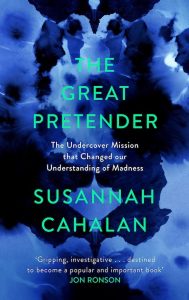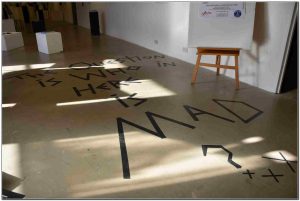The Great Pretender: The Undercover Mission that Changed our Understanding of Madness by By Susannah Cahalan. Published by Canongate (2020). Reviewed by Helen Spandler.

Many Asylum readers will be familiar with ‘Being Sane in Insane Places’, David Rosenhan’s classic study that, as Susannah Cahalan states, put a ‘dagger in the heart of psychiatry’. To recap: eight ‘sane’ people presented themselves to various mental hospitals in the US in the early 1970s complaining of relatively harmless sounding voices like ‘empty’, ‘hollow’ and ‘thud’. Most of these ‘pseudo patients’ were admitted to hospital with a diagnosis of schizophrenia, despite having no other symptoms, and despite not mentioning their voices again after they were admitted. Once hospitalised, their ‘normal’ behaviour was seen by staff as evidence of their mental illness. When eventually discharged, they were all told they had ‘schizophrenia in remission’.
It was a pretty damning study. Understandably, it was welcomed by the growing anti-psychiatry movement as evidence that psychiatry was flawed and the diagnosis of schizophrenia – what Thomas Szasz referred to as the ‘jewel in the crown of psychiatry’ – was a sham. The study was published in 1973 when psychiatry was faced with One flew Over the Cuckoo’s Nest and Gay Liberation challenging psychiatry’s classification of homosexuality as a mental disorder.
But was Rosenhan’s study ‘too good to be true’? Or, more accurately, too bad? Susannah Cahalan has written a fascinating book which exposes some serious flaws in the psychologist’s study. Whilst it might be tempting to dismiss Cahalan’s book as an attempt to discredit critics and bolster the psychiatric profession, I think that would be unfair. She refers to the ‘horror show of the US mental health system’ and positively references the Soteria project as an alternative, having overcome her initial scepticism.
Cahalan’s main concern is the plight of people who end up with a long-term psychiatric diagnosis. After all, this could have easily happened to her. She’d been hospitalised as ‘mentally ill’ until a doctor discovered she had an underlying rare, but treatable, auto-immune disease which caused severe psychotic symptoms. She knows first-hand the limits of psychiatric knowledge and the poor treatment given to those with a psychiatric diagnosis – her care and treatment rapidly improved after she got her new non-psychiatric diagnosis.

Cahalan was a budding journalist before she became ill and, when recovered, decided to use her skills to investigate Rosenhan’s study as its conclusions resonated with her own experiences. She interviewed hundreds of people, accessed Rosenhan’s fieldnotes and unpublished papers and even hired a private detective to identify the pseudo patients. One of them was certainly Rosenhan himself, but he had died so couldn’t give his account. Despite considerable effort, she was only able to identify two others, leaving her with the disturbing possibility that some of them might not even have existed. They may exist, we don’t know.
But what about the two pseudo patients she did identify? One of their accounts broadly supported Rosenhan’s analysis, however the other didn’t. When this patient presented himself to the psychiatrist, he realised he was actually depressed, and was admitted to what he experienced as a caring and benign hospital environment. It may be that his experience was unrepresentative – it sounds as if he ended up in a ward run on therapeutic community type principles. However, Rosenhan excluded this patient from the study (he just appears as a footnote). Whilst Rosenhan’s study is one of the most well-known papers ever written about psychiatry, an article this pseudo patient subsequently wrote about his experience is little known (I’d certainly never heard of it).
Another problem Cahalan found was that some of the pseudo patients exaggerated their ‘symptoms’ to ensure they got hospitalised. After all, the pseudo patients volunteered for the study because they wanted to find out what it was like to be a patient in a psychiatric hospital. If they hadn’t got admitted there would have been no story, and no publishable findings. At least one told the psychiatrists he was actively suicidal and felt a profound sense of emptiness (putting their ‘empty’, ‘hollow’ and ‘thud’ voices in a rather different light). Whether someone should be given a diagnosis of schizophrenia and hospitalised on this basis is of course questionable, but this important detail isn’t mentioned in Rosenhan’s study.
Is Cahalan guilty of the same charge as Rosenhan – of creating a good story out of a complex and conflicting reality? Possibly. She probably overplays the negative impact that Rosenhan’s study had on psychiatry. For example, I don’t think it can be blamed for the negative effects of de-institutionalisation policy in the US (poverty, homelessness, lack of community care, etc) as she suggests. As Cahalan herself concedes, de-institutionalisation pre-dated Rosenhan’s study and was as much a political as a psychiatric initiative. However, I think she is probably correct that rather than admitting the limits of its knowledge, psychiatry responded by increasing its efforts to demonstrate its scientific credentials, ‘doubling down on certainty where none existed’. Robert Spitzer, the psychiatrist who drafted the new diagnostic classification system (DSM-III), apparently kept asking himself ‘would Rosenhan’s pseudo patients get past these criteria?’ They didn’t want anything as embarrassing as this ever to happen again.
What lessons people will draw from this fascinating investigation will depend on our prior perspective. And therein lies the problem.
It’s important not to single out Being Sane in Insane Places as an unusual example of poor research – in psychology, psychiatry or science in general. There are plenty of other examples. For example, the recent million £ psychiatric-led PACE research study which claimed to demonstrate the effectiveness of CBT and graded exercise for people with ME/CFS. That study has since been discredited following Freedom of Information requests from patient activists.
Does it matter if Rosenhan’s study wasn’t entirely accurate, if it highlighted some broader truths about psychiatry? Indeed, some of the conclusions of Rosenhan’s study do still ring true. For example, psychiatric diagnosis can result in all aspects of a person’s behaviour being pathologized, and psychiatric hospitals can be depersonalising, invaliding and counter-therapeutic.
However, the defence that the ‘ends justify the means’ is a dangerous argument, especially in psychiatry. Quite rightly, many of us who are critical of psychiatry call out psychiatric studies for biases or falsifications. For example, drug trials which are big pharma funded and fail to report negative effects. But can we have it both ways? I don’t think it’s acceptable to fabricate research results to suit our own agenda.
What is clear, both from Rosenhan’s study and Cahalan’s investigation of it, is that the debate about psychiatric legitimacy is far from over. While Cahalans’ exposé may question Rosenhan’s study, it doesn’t support the claim that psychiatry is scientific, or that the diagnosis of schizophrenia is valid or reliable. More importantly, it shouldn’t result in any less criticism of psychiatric abuses, poor treatment or neglect. Survivors’ testimonies continue to attest to this – including Cahalan’s own.
Susannah Cahalan documented her own experience in her previous book, Brain on Fire (which was also made into a film of the same name).
This is a sample article from the Summer 2020 issue of Asylum magazine
(Volume 27, Number 2)
To read more . . . subscribe to Asylum magazine.
